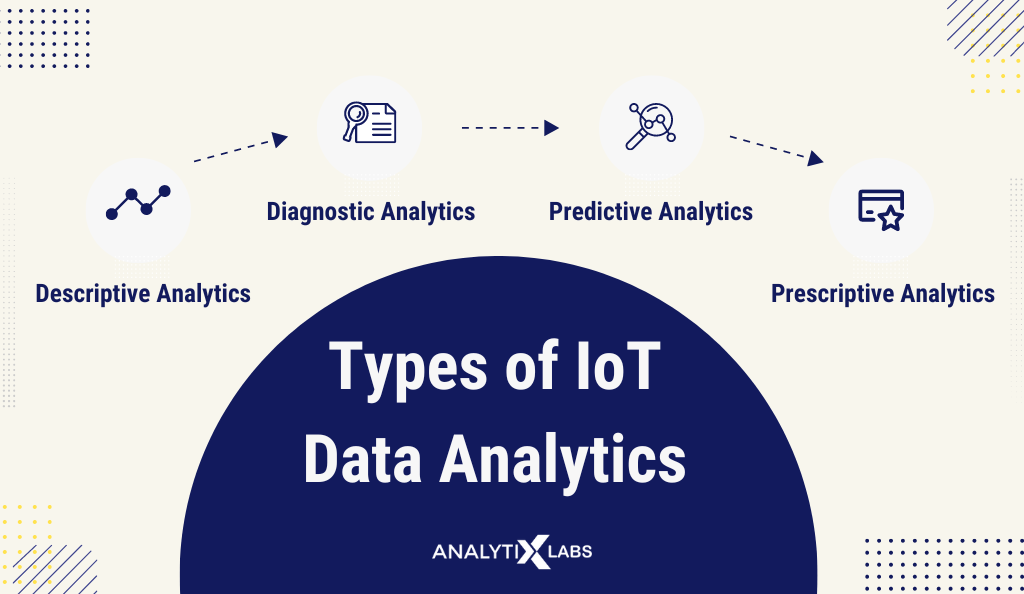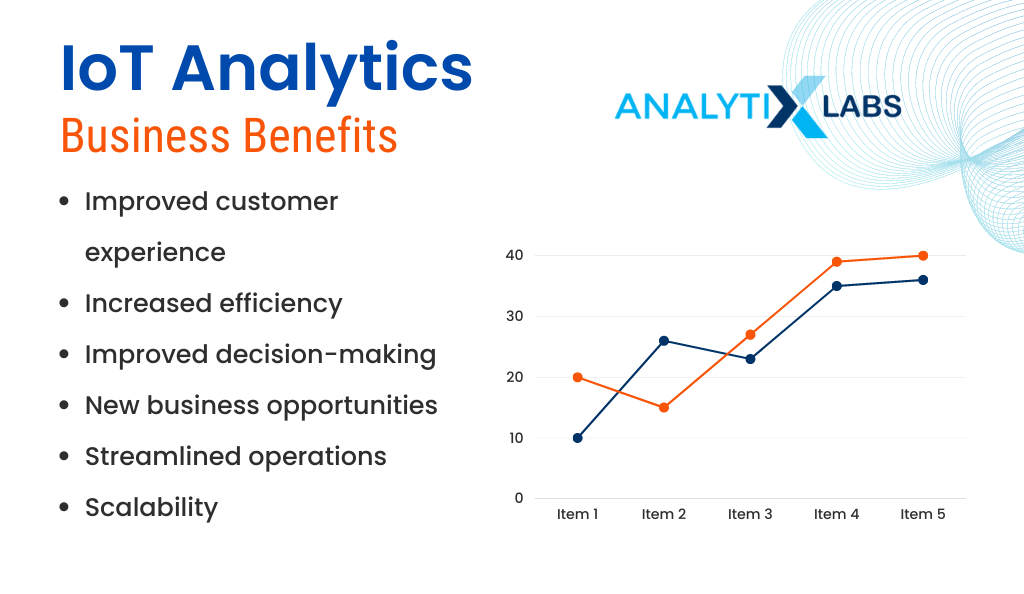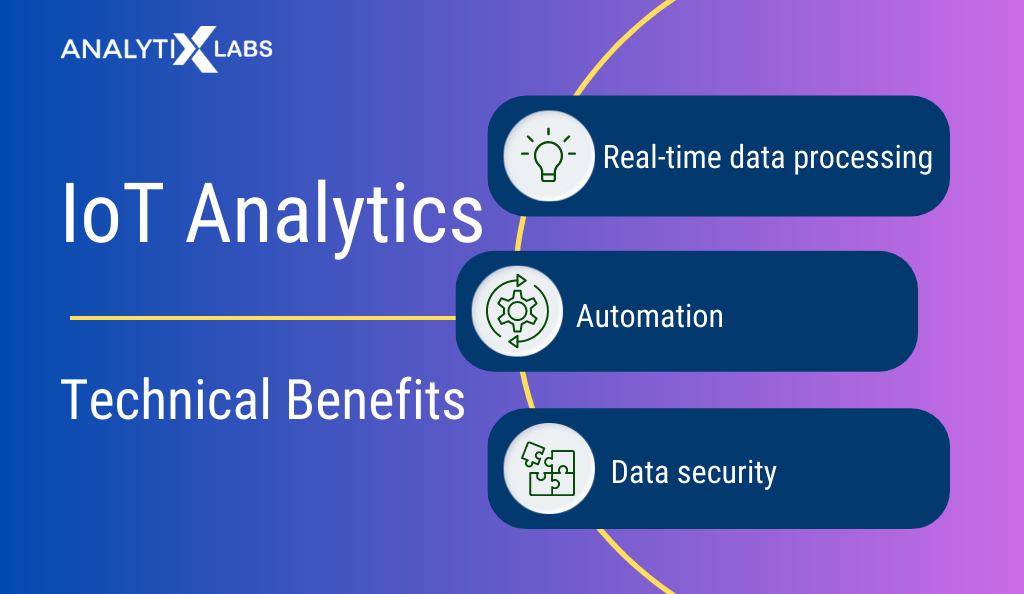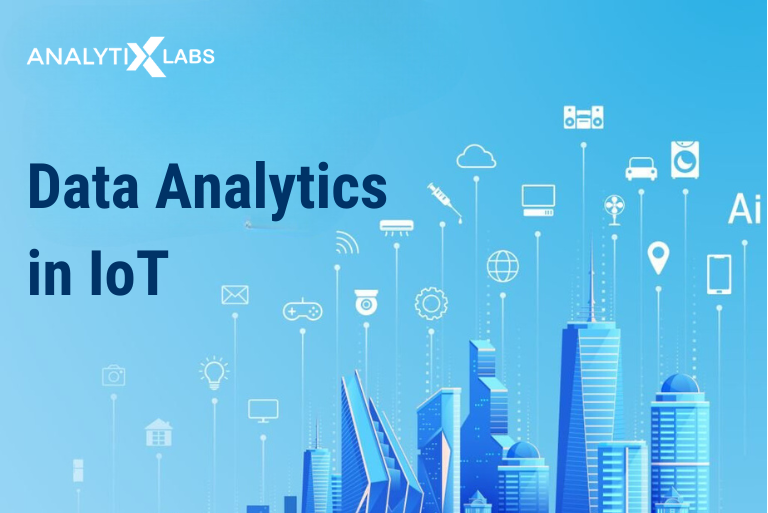In today’s connected world, sensors and linked devices are helping businesses gather enormous amounts of data that can be used to create value. Data analytics is critical to the Internet of Things (IoT) as it helps extract, store, and analyze various data types from connected devices. As a result, it allows businesses to gain valuable insights into their operations, customers, products, and services.
IoT data analytics also helps enterprises reduce costs and improve efficiency. Analyzing incoming streams of IoT data provides organizations with actionable data insights that can be utilized to enhance their goods and customer experiences. It helps identify and reduce operational risk, find and fix inefficiencies, and discover new income opportunities.
In this article, we will look closer at the types of IoT data analytics, their relation to big data analytics, and the Industrial Internet of Things (IIoT). We will also discuss the benefits analytics in IoT can bring to businesses, how to efficiently implement it in an organization, and some of the devices powered by IoT analytics.
What is IoT Analytics?
As the name suggests, IoT analytics is the process of evaluating data generated and gathered by IoT devices using a particular set of data analytics tools and techniques.
IoT data analytics aims to transform enormous amounts of unstructured data from numerous heterogeneous devices and sensors in the Internet of Things ecosystem into insights.
The knowledge can be used to support additional data analysis and drive solid business decision-making. Moreover, IoT analytics makes it possible to spot patterns in data sets. It can be used to forecast and alter future events.
Machine learning algorithms, data visualization tools, and other sophisticated analytics software are useful for IoT analytics. Some IoT analytics approaches are real-time analytics, big data analytics, and streaming analytics.
The combination of these technologies enables businesses to keep up with changing customer demands, make informed decisions promptly, and differentiate their services through predictive intelligence.
Types of IoT Data Analytics

IoT Analytics can be broken down into the following four categories:
- Descriptive Analytics
- Diagnostic Analytics
- Predictive Analytics
- Prescriptive Analytics
Descriptive Analytics
Descriptive analytics uses gathered data for fundamental knowledge, detect pattern detection, and spot trends and linkages.
Descriptive analysis often involves segmentation, clustering, and other data mining techniques to understand the behavior of a particular customer, product, or service. Businesses may find assets, assess device usage, and spot anomalies using descriptive analytics.
An instance of using descriptive analytics by a factory is to comprehend the distribution of their products and determine the typical production time. They must also know the range of typical production times and the proportion of products produced within a specific period. The insights help improve the production process to achieve higher efficiency using this knowledge.
Diagnostic Analytics
Descriptive analytics concentrates on the “What?” question and diagnostic analytics goes further and concentrates on the “Why?”. In diagnostic analytics, the software focuses on understanding the past and identifying what happened.
It delves deep into historical data to identify the underlying causes of specific problems and explain why they exist. It aims to assist companies in locating the issue and streamlining their processes.
For instance, a company could employ diagnostic analytics to pinpoint the source of production bottlenecks. They could examine data from their manufacturing line to identify the exact causes of the slowdown, such as a machine that keeps breaking down or a process that is taking longer than intended.
With this knowledge, firms can increase efficiency by making targeted adjustments to their production process.
Predictive Analytics
Predictive analytics implements machine learning algorithms to forecast future occurrences or outcomes based on historical data. It focuses on finding patterns to give businesses insightful information about upcoming trends, patterns, and behaviors.
As a result, organizations can foresee problems and make data-driven decisions to prevent them.
For instance, it enables businesses to anticipate customer needs. They can make recommendations about upcoming changes in the marketplace and proactively address problems before they happen.
They might find patterns and links in the data by examining past sales data, such as the effects of particular promotions or events on sales. With this knowledge, organizations can make wise decisions regarding future promotions and marketing initiatives, enhancing sales and higher revenue.
Prescriptive Analytics
Prescriptive analytics is all about taking action based on insights derived from the data. It not only forecasts the future but also offers suggestions and suggested courses of action based on data produced by IoT devices.
Prescriptive Analytics enables businesses to use AI-driven models to analyze the impact of different decisions and recommend smart solutions that will help them increase their efficiency or profits.
For example, using sales data, a store can adjust its inventory levels to minimize the risk of stock shortages and excess inventory. Using prescriptive analytics, the management can project future demand and make products available accordingly.
Also read: 5 Types of Business Analytics
IoT + Big Data Analytics + IIoT
The Industrial Internet of Things (IIoT) and the Internet of Things (IoT) have revolutionized IoT data collection and analysis. The combination of IoT, IIoT, and Big Data analytics has revolutionized how organizations operate today. It helps create smarter processes, manufactures customer-centric products, improves decision-making, improves operational efficiency, and enhances customer experience.
Companies can collect large amounts of real-time data as more devices are connected through IoT networks. It can be used for predictive analysis using Artificial Intelligence (AI) and Machine Learning (ML). Moreover, vast amounts of data from connected devices, sensors, and machines are organized to provide valuable insights.
Also read: Understanding the Role of AI in Big Data [and vice-versa]
Big Data analytics is required to extract meaningful insights from the data. Using advanced analytics tools, data scientists can identify patterns, trends, and anomalies in the data that would be impossible to uncover through traditional analysis methods.
The combination of IoT and IIoT, and Big Data analytics can potentially transform many industries. For example, IoT sensors can be used in manufacturing to check machine performance. And on the other hand, Big Data analytics can easily identify trends in equipment failures. Thereby leading to proactive maintenance and reduced downtime.
IIoT builds on IoT by connecting industrial machines, devices, and sensors. It can be used in various industries, such as manufacturing, energy, and transportation.
IIoT devices generate vast amounts of data to optimize processes, improve efficiency, and reduce costs. Big Data analytics is critical to make sense of this data and enable informed decision-making.
Why do we need IoT Analytics?
IoT analytics can help organizations better understand the data generated by IoT devices and make informed decisions. It can provide an overview of the health of the organization’s connected systems, identify any issues or anomalies and make recommendations based on patterns detected in the data.
Organizations can use these insights to develop strategies for growth, improve operational efficiency and reduce costs. The scope of IoT analytics is vast, ranging from predictive maintenance to customer segmentation and targeted marketing campaigns.
For example, IoT sensors can be used in manufacturing to check machine performance and determine potential issues before they cause downtime or equipment failures. In the transportation industry, IoT sensors track the location and condition of vehicles and cargo.
Big Data analytics can then analyze data from both industries and identify patterns. It helps derive information regarding delivery times, routes, and customer demand. The insights can improve the performance of both industries by improving efficiency from manufacturing to last-mile delivery.
Additionally, predictive maintenance can schedule repairs and replacements for machines and vehicles before they break down. Thereby reducing downtime and improving overall performance.
Business Benefits of IoT Analytics

-
Improved customer experience
IoT analytics can help businesses gain insights into customer’s behavior and preferences. It enables businesses to tailor their products and services to meet customer’s expectations and provide a better customer experience.
Also read: What is Customer Analytics?
-
Increased efficiency
Analytics in IoT can help businesses optimize their operations by identifying areas of inefficiency and waste. By analyzing the data generated by IoT devices, businesses can identify areas that require improvement and make informed decisions about resource allocation. It reduces operating costs and enhances profitability.
-
Improved decision-making
IoT analytics can help businesses make data-driven decisions based on insights into their operations and customers. Businesses can get a deeper understanding of their operations by analyzing the data generated by IoT devices. This can help make informed decisions about resource allocation, product development, and customer engagement.
-
New business opportunities
Analytics in IoT can help businesses identify new business opportunities by providing insights into customer behavior and market trends. By analyzing the data generated by IoT devices, businesses can identify emerging trends and customer needs. This can help in creating new products and services that meet these needs.
Also read: Top Data Analytics Companies in India to Work With
-
Streamlined operations
IoT analytics helps to streamline operations by providing real-time visibility into all aspects of a connected system. This insight can identify potential bottlenecks, manage resources more effectively and obtain a comprehensive overview of device performance at any given time.
Also read: What is HR Analytics?
With this data, organizations can quickly adapt to changing conditions and optimize processes for greater efficiency and productivity.
-
Scalability
IoT analytics provides scalability so organizations can quickly adapt their systems to changing circumstances as they grow and evolve. This flexibility allows businesses to rapidly implement new strategies while efficiently managing complex environments with various connected devices.
As a result, businesses can maximize the value of their IoT investments while reducing the time, effort, and cost associated with upgrading their existing infrastructure.
Technical Benefits of IoT in Analytics

-
Real-time data processing
IoT analytics platforms can handle a large volume of data in real time. The analytics tools can analyze this data in real time, enabling businesses to make timely decisions and gain insights.
Also read: Understanding exploratory data analysis in Python
-
Automation
IoT analytics can enable businesses to automate certain processes that would otherwise require manual intervention. This can significantly reduce labor costs and allow employees to focus on more important tasks.
Additionally, automation ensures consistency in operations and eliminates human error, resulting in greater accuracy and efficiency.
-
Data security
IoT analytics platforms can provide data security features that protect customer data privacy. Data encryption, access controls, and threat detection are some of the features offered by analytics in IoT.
These features are critical in ensuring IoT data is secure and protected from unauthorized access.
Implementing IoT Analytics in an Organization
Implementing IoT analytics in an organization can be a daunting task. Creating a cohesive solution requires significant planning, implementation, and integration of the various components.
Here are some tips on how to effectively implement IoT analytics in an organization:
-
Data gathering
IoT Data collection from devices is the initial stage in IoT analytics. It includes integrating the devices with sensors or other data-collecting tools and joining a network that allows data transmission.
-
Data storage
After collecting the information, it must be kept in a central database or repository. This can be achieved with an on-premises server, storage system, or a cloud-based solution.
-
Processing data
Data must be examined after it has been collected and stored. You can use advanced software to clean, process, and filter the data. It helps you extract precise insights and prepare reports.
-
Data visualization
Data visualization via charts, graphs, and maps makes the insights and analysis produced by IoT analytics easier to understand. This helps study data trends, patterns, and connections that might not be immediately clear from raw data alone.
Also read: Data Visualization: Key Terms
-
Decision-making based on data
Using analytics in IoT helps create actionable insights for faster decision-making. By understanding how certain factors influence each other, businesses can make informed decisions to improve their bottom line.
Devices Powered by IoT Analytics
IoT devices are hardware objects that collect and exchange data online, including gadgets, sensors, and appliances. These can be integrated into other IoT devices and are programmed to connect with similar devices.
These devices can be remotely used through remote monitoring systems and mobile applications:
-
Wearables
Wearables are tiny IoT devices worn on the body to track health data and vitals. It has several applications, from everyday and remote patient monitoring to employee health tracking in extreme environments.
With features like heart rate and sleep monitoring capabilities, wearables are useful tools for managing fitness and ensuring safety. Real-time data sharing allows immediate action in an emergency. The system also triggers an alarm to flag an emergency, providing details like temperature, heart rate, and oxygen levels.
-
Smart homes
Smart homes are equipped with IoT sensors that can interact with and control various home appliances, such as security and alarm systems or lighting, appliances, and climate control systems.
The homeowner can program these devices to respond based on certain conditions like temperature or light level, giving them complete control over their living environment.
These systems may be accessed and managed remotely. You can remotely turn the devices on or off using your phone or tablet and even change settings.
Again, a lot of data is gathered from these IoT devices to evaluate consumption trends and boost the effectiveness of a smart home.
-
Voice-activated assistants
Digital assistants are IoT devices that are rapidly dominating our daily lives. They can do various tasks, like taking notes, playing music, and providing weather predictions. Routine updates enhance voice systems’ functionality.
These little bots have gained popularity in recent years because they provide customized services depending on our regular interactions with them. AI-powered digital assistants are becoming increasingly more intuitive and can recognize natural language.
How Does IoT Analytics Work?
Several devices are constantly producing massive volumes of data. IoT analytics can help you analyze this data across all connected devices. IoT analytics typically involves a combination of hardware, software, and cloud-based services that collect, process, analyze and visualize the data.
Computational power and data storage must scale up or down following changes in your organization’s needs.
Let’s go over how to use analytics in IoT in just five easy steps.
- The initial stage is to collect data from diverse sources in various formats and at varying frequencies.
- After that, the data is processed using a range of computational resources.
- The data is then kept in a time series for upcoming studies.
- Various strategies, including specialist analysis tools, standard SQL queries, and machine learning analysis techniques, can be used to conduct the analysis. Many predictions can be made based on the results.
- Companies can use the information they obtain to develop various systems and applications to assist corporate operations.
FAQs
What is the concept of analytics?
Internet of Things (IoT) analytics enables businesses to use the enormous volumes of data that IoT devices generate using analytics stacks. IoT analytics is sometimes viewed as a subset of big data because it entails merging diverse data streams and turning them into reliable insights.
Organizations can enhance their operations with the help of the insights provided by IoT streams. However, integrating the various IoT device types with already-existing ecosystems and analytics tools is complex.
What are the main categories of analytics in the IIoT?
In general, there are four primary categories of Industrial Internet of Things (IIoT) analytics:
- Descriptive Analytics: Gathers and interprets real-time data from IoT devices
- Diagnostic Analytics: Builds on the initial understanding from descriptive analytics and describes the happenings.
- Predictive Analytics: Incorporates machine learning (ML) capabilities to forecast future events based on historical data
- Prescriptive Analytics: Gives recommendations and suggestions for improving the effectiveness of descriptive, diagnostic, or predictive analytics.
How many types of analytics are needed for IoT?
The analytics in IoT are classified according to the problems they solve. There are four main types, namely:
- Descriptive analytics
- Diagnostic analytics
- Prescriptive analytics
- Predictive analytics









1 Comment
Interesting post, thanks for sharing.